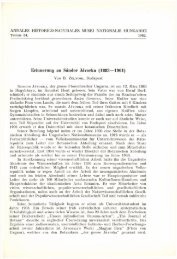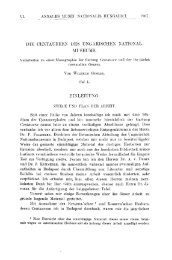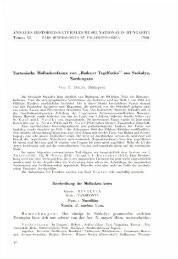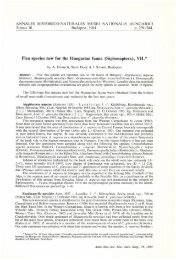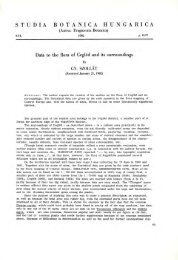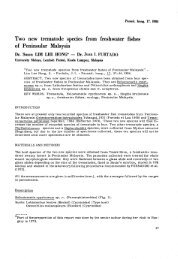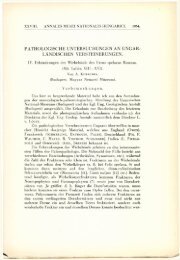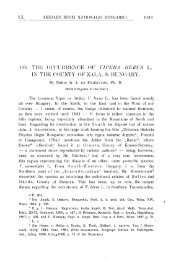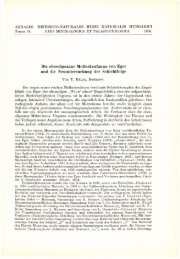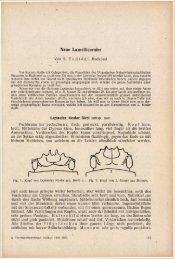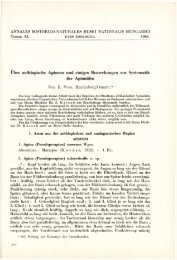New and little-known species of Carabidae from the Middle East and ...
New and little-known species of Carabidae from the Middle East and ...
New and little-known species of Carabidae from the Middle East and ...
Create successful ePaper yourself
Turn your PDF publications into a flip-book with our unique Google optimized e-Paper software.
38 E. Kirschenh<strong>of</strong>er<br />
intervals 5 to 7 but reduced on 5; a preapical spot covering intervals 1 to 3 <strong>and</strong> semi-circular<br />
on hind margin, not reaching apex; venter <strong>and</strong> elytral epipleura smooth, shiny, yellow,<br />
with fine short yellow setation. Elytral intervals in basal fifth medially distinct, weakly <strong>and</strong><br />
carinately convex; outer intervals with a row <strong>of</strong> very fine punctures bordering striae; striae<br />
moderately deep, smooth <strong>and</strong> without punctures at bottom; third interval with two porepunctures.<br />
Microsculpture: dorsum with silky lustre due to dense microsculpture; head<br />
<strong>and</strong> pronotum densely transversely lineolate; elytra very finely isodiametrically reticulate.<br />
Distribution – Vietnam.<br />
Etymology – It is named after <strong>the</strong> provenance.<br />
Comparisons – The new <strong>species</strong> is compared to Lebia calycophora<br />
SCHMID-GÖBEL, 1846 (type locality: “Birma”, holotype, NMP, examined).<br />
For distribution <strong>of</strong> this <strong>species</strong> see JEDLIÈKA (1963). The elytral spots in<br />
Lebia calycophora are contiguous: <strong>the</strong> basal spot is connected to <strong>the</strong> median<br />
spot along <strong>the</strong> suture. In Lebia cucphuongensis sp. n. all spots are well isolated.<br />
(Fig. 28)<br />
sp. n.<br />
Type material – Holotype (female): “Vietnam: Tuong linh near Phuly, 24.–28.V.<br />
1966, Exp. Gy. Topál/Nr. 565, collected by lamp” (HNHM). Paratype (female): with <strong>the</strong><br />
same data as <strong>the</strong> holotype (HNHM).<br />
Description – Habitus: Fig. 28. Length 3.8 mm, width 1.9 mm. Colour <strong>and</strong> lustre:<br />
head, pronotum <strong>and</strong> elytra reddish yellow; elytra with a black transverse b<strong>and</strong> extending<br />
laterally up to interval 9 <strong>and</strong> extended forward in steps on intervals 3–1, more so on 1, <strong>and</strong><br />
sinuately excised along rear on intervals 1–4; lateral margin <strong>and</strong> apex reddish yellow; palpi,<br />
antennae <strong>and</strong> legs reddish yellow. Outline: small, strongly ovoid. Pronotum: sides strongly<br />
narrowing anteriorly in even arch, but narrowing backwards to short <strong>and</strong> rounded posterior<br />
angles in very flat arch. Elytra: broadly oval; posterior margin <strong>of</strong> elytra almost straightly<br />
truncate, only very weakly arcuate. Microsculpture <strong>and</strong> lustre: dorsum satiny due to dense<br />
chagreen; head very finely transversely lineolate; pronotum densely rugulose, interspersed<br />
with fine transverse <strong>and</strong> indistinct reticulation; elytra minutely <strong>and</strong> transversely reticulated.<br />
Distribution – Vietnam.<br />
Etymology – It is named after <strong>the</strong> provenance.<br />
Comparisons – This <strong>species</strong> resembles Lebia roubali JEDLIÈKA, 1951<br />
(type locality: “Taiwan, Kuraru”, holotype, NMP, examined) in size, outline<br />
<strong>and</strong> elytral spots. The dark sutural b<strong>and</strong> on elytra is dilated up to <strong>the</strong><br />
lateral margin behind <strong>the</strong> middle in L. tuongensis sp. n., in L. roubali only to<br />
<strong>the</strong> fifth interval.<br />
Annls hist.-nat. Mus. natn. hung. 102, 2010



